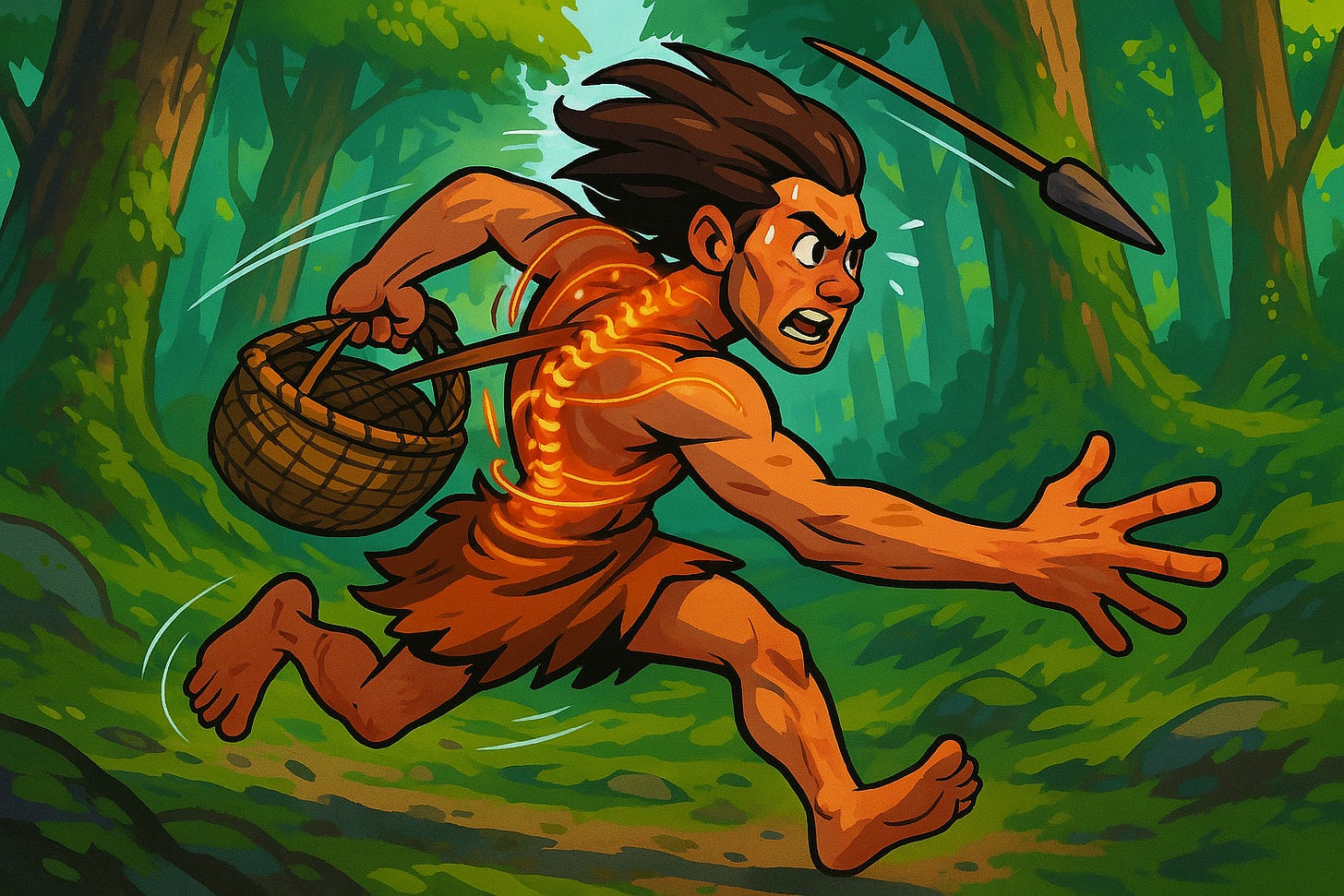Survival and Movement
Move Like Your Life Depends on It
Hey friends and fam! If you know me at all, then you know I’m always thinking about movement as it relates to health and performance. After some deep podcast chats with David Weck, I’ve been thinking hard about an idea he shared: human survival as the ultimate metric for understanding, analyzing, and teaching movement. Thinking about this idea has enriched how I see every step I take. At our core, we are apex predators. Our ancestors didn’t hit the gym for biceps or squat PRs. They moved to live, to survive and to thrive, by developing physical capacity in locomotion, swinging, throwing, catching and carrying. It’s a first-principles anchor to answer “What is movement for?” Not six-pack abs or Instagram likes, but physical capacity to thrive. This principle can guide how we train, how we analyze what works, and how we teach it.
But why doesn’t it? Our fight-or-flight response ability made us so successful as a species that now, sitting on our couches with takeout, we don’t even think about survival anymore. Modern life’s a far cry from what forged our physical capacity. Also, the mainstream fitness industry is steering us in the wrong direction.
Modern Life’s Disconnect
First off, the world we live in now is light-years from what shaped us. Back then, locomotion meant outrunning a predator or trekking miles for water. Throwing was life-or-death. Miss the deer, and you’re hungry. Even if you make the kill, can you carry it back to camp? Those capacities were high stakes, baked into our DNA over millennia. Today? I’m typing this at a desk, and you’re probably reading it on a phone. Survival is a grocery run or a Zoom call. Our bodies are built for apex-predator action, but we’re barely tapping that capacity with sedentary lifestyles.
However, even a sedentary person still takes over a million steps a year. Locomotion is still an inexorable part of the human experience whether you’re just walking, running or playing a field sport. Each step is a rep, and if those reps are sloppy and unbalanced, then we’re wearing ourselves out rather than fortifying ourselves. David Weck says, “Every ancestor that made it, walked with perfect balance.” I’ve enjoyed my runs more as I think about running like a hunter whose life depends on a successful kill, making it smoother, more efficient, and effortless. It’s more fun that way.
Mainstream Fitness Industry
Besides modern life dulling our connection to survival as a source of movement knowledge, the mainstream fitness industry also steers us in the wrong direction by teaching that the spine's primary function is to resist rotation. This is epitomized by the Pallof press exercise, where you brace hard, squeezing the whole body against an external force, training a “deer in headlights” response. David Weck calls it “insidiously harmful” because it trains a glitchy, nervous nervous system, leaving you hesitant and primed for a career-ending non-contact injury. Movement for survival isn’t stiff. It’s fluid, coiled, and rotational.
Mainstream fitness industry divides movement into separate planes like sagittal (front-back), frontal (side-side), and transverse (twist), then concludes that it’s optimal to brace the core and keep the spine stiff as we move through these planes individually. However, survival doesn’t care about planes. Locomotion and the other capacities of survival require the spine to coil across all planes simultaneously. A stiff, segmented approach betrays our design, dulling the fight-or-flight response ability we’re built for.
Summary and Conclusions
Survival is the ultimate metric for understanding movement. Locomotion, swinging, throwing, catching, and carrying are the roots of movement for us humans as apex predators. However, now we’re parked at desks, steps are to the fridge, and survival’s a non-issue. Furthermore, the mainstream fitness industry has fragmented movement and pushed stiffness over spinal fluidity, resisting what survival demands. We’ve drifted far from our ancestral blueprint but we can shift the focus back on survival by relating to gait. Locomotion is an unavoidable part of being human even when sedentary. By coiling the spine, we can learn to walk with perfect balance cultivating joy in movement for the long run.
Connect with J-Mart on Social Media
Nostr - npub1cqfrrgxs6mwpl2xpmh2kzw322qv2n0e4r65jllzncv65krmvwhnsct3p5u
Email - jmartfit@substack.com
Instagram - https://www.instagram.com/jmartfit/
Facebook - https://fb.me/jmartmoves
Medium - https://jmartwrites.medium.com/
You can also check out my State of Health Podcast (health education geared) on the platform of your choice:
Apple -
Spotify -
Amazon Music - https://music.amazon.ca/podcasts/01bb34c0-00a2-45e2-8627-95c32aba7c0e/state-of-health


